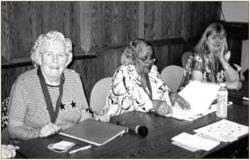Hospital Sketches #7:
Rose of Sharon/Tennessee Rose by Janet Perkins
51st Ohio Volunteers in Nashville, March, 1862
Lithograph from a drawing by Ohio soldier Alfred E. Matthews
In February, 1862 Confederate troops abandoned Tennessee's capitol Nashville. The Union Army marched into the undefended city. Occupation by Federal Forces began.
The Union commandeered hotels, schools and warehouses for hospitals.
In late 1863 as nearby battles filled the city with wounded men Annie Bell was assigned as matron at Nashville's Cumberland Hospital ( #1).
A few months later this famous photograph of Bell was taken. Collector Chris Foard found a letter from Bell to her mother:
Foard's find explains the circumstances behind this photo and probably several similar pictures of hospitals and soldiers. The Sanitary Commission sent photographers, duplicated the carte-de-visites and sold them at the various Sanitary Fairs in 1864.
Nashville Female Academy
"Barracks of the 51st Regt. O.V."
By Alfred E. Matthews
The Union commandeered hotels, schools and warehouses for hospitals.
Matron Annie Bell (1839-1916) about 27 when the photo was taken
In late 1863 as nearby battles filled the city with wounded men Annie Bell was assigned as matron at Nashville's Cumberland Hospital ( #1).
"I send you a picture, one of the persons you will perhaps recognize. Two weeks ago, some of the Sanitary Commission people came to see me & asked that I would allow an artist to take a hospital scene, that they wanted such a one to sell at the fair at Cleavland.... I consented—and now there is quite a rage for the picture..."https://militaryimages.atavist.com/hospital-scene-backstory-spring-2017
Foard's find explains the circumstances behind this photo and probably several similar pictures of hospitals and soldiers. The Sanitary Commission sent photographers, duplicated the carte-de-visites and sold them at the various Sanitary Fairs in 1864.
This photo with a weary-looking Bell in the center may have been
taken the same day.
Rose of Sharon/Tennessee Rose by Bettina Havig
Annie Bell in her late twenties was young to be given the responsibility of a 900 bed hospital in an occupied city but her competence and confidence was equal to that of her older peers. Born into a prosperous family of foundry owners in Pennsylvania, she was a graduate of Bucknell University. Dorothea Dix considered her too young to be permitted into her nurse corps but Annie had proved her worth at field hospitals after the Battle of Gettysburg.
On Christmas day, 1864 H. H. Maley wrote his parents from Nashville's Hospital #1:
On Christmas day, 1864 H. H. Maley wrote his parents from Nashville's Hospital #1:
"Their is some wounded rebs here they are used the same our men is.... They got all of our men that was wounded at franklin and all the rebs.. this Hospital is the best fixed thing I ever saw. We have very good grub and git enough of it...."A compliment to the Matron.
Rose of Sharon/Tennessee Rose by Myrna Powers
The Block
Mid-19th century version
Eight-lobed flowers were the standard floral imagery in applique, perhaps derived from Germanic folk arts. Often called the Rose of Sharon the image is linked to an old testament reference: "I am the rose of Sharon, a rose of the valley". This pattern is asymmetrical with a stem off to one corner.
Woman's World magazine sold a pattern for a Tennessee Rose about 1930, the perfect name for this month's block.
To Print:
Create a word file or a new empty JPG file.
Click on the image above.
Right click on it and save it to your file.
Print that file. Be sure the square is about 1" in
size.
Cutting:
For the background cut a square 18-1/2".
For the background cut a square 18-1/2".
Add seam allowances to the pattern pieces if you are
doing traditional applique.
Addition
Becky added 8 yellow circles under piece B
Subtraction
Barbara left out Piece D.
Block 7 is directional so goes in a corner.
I'm rotating my corners around so there is no right side up to my quilt.
You can see we have only two more blocks to go in our 9-block applique sampler.
Cut a 9" square
1 Each of A & B
Use 1 smaller leaf from Block 6.1/2” Finished bias stem
Denniele Bohannon's #7 Rose of Sharon Sprout
Improved by addition
After the War:

Nashville's Hospital #15 in the last month of the war

Nashville's Hospital #15 in the last month of the war
The Bell family home in Bellwood, Pennsylvania still stands.
Annie Bell went home to Blair County, Pennsylvania in May, 1865, marrying Maine doctor George Stubbs a few months later, another hospital romance. They spent much of the rest of their lives in Merion near Philadelphia where they raised three daughters and a son. Annie died at 76 years old in 1916 after receiving a nurse's pension for the last years of her life.
Sampler dated 1857 with wreaths, two coxcomb & currants blocks
and a Rose of Sharon among the designs.
Collection of the Historical Society of Plainfield.
New Jersey project & the Quilt Index.
Rose of Sharon/Tennessee Rose by Paula Smith
See more pattern history at this post:
Extra Reading:
https://civilwarnashville.wordpress.com/



























































